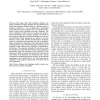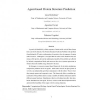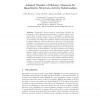6192 search results - page 172 / 1239 » Structure benefits all |
JMM2
2007
13 years 10 months ago
2007
— This paper deals with automatic dialogue acts (DAs) recognition in Czech. Dialogue acts are sentence-level labels that represent different states of a dialogue, such as questio...
JSAC
2007
13 years 10 months ago
2007
— To achieve high performance and resilience to failures, a client can make connections with multiple servers simultaneously and receive different portions of the data from each ...
MAGS
2007
13 years 10 months ago
2007
A protein is identified by a finite sequence of amino acids, each of them chosen from a set of 20 elements. The Protein Structure Prediction Problem is the problem of predicting...
TKDE
2002
13 years 9 months ago
2002
Since WWW encourages hypertext and hypermedia document authoring (e.g. HTML or XML), Web authors tend to create documents that are composed of multiple pages connected with hyperl...
DIS
2010
Springer
13 years 8 months ago
2010
Springer
Quantitative structure-activity relationships (QSARs) are regression models relating chemical structure to biological activity. Such models allow to make predictions for toxicologi...



